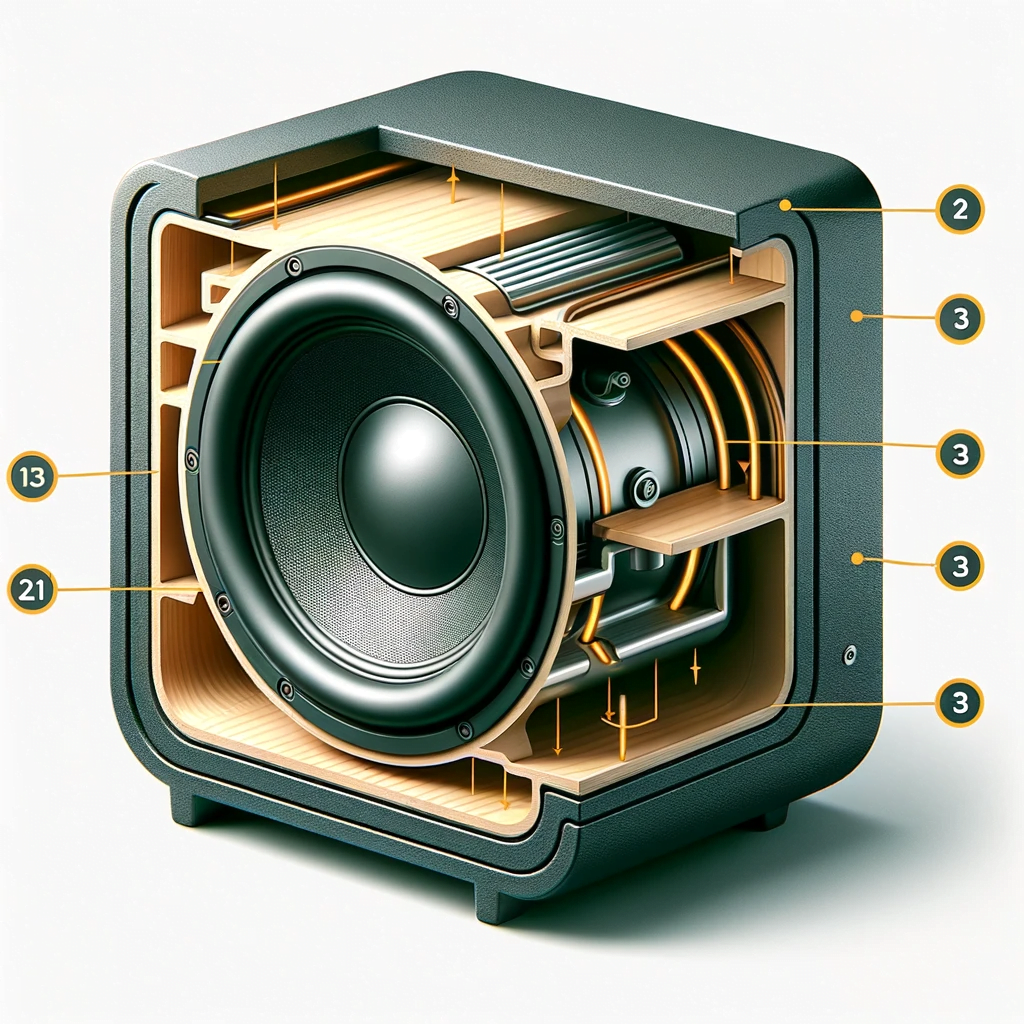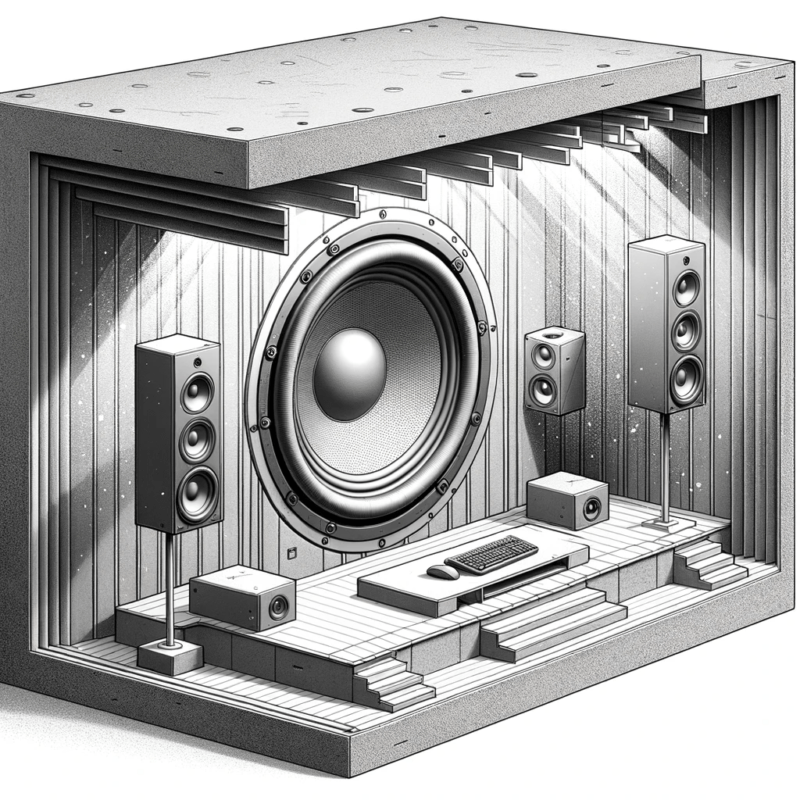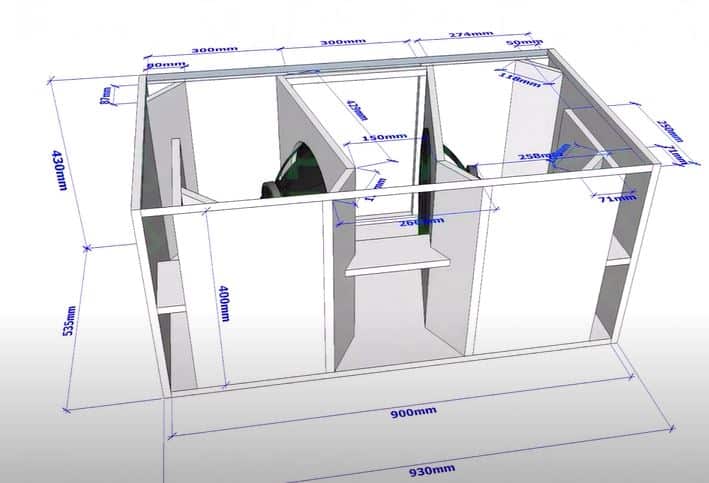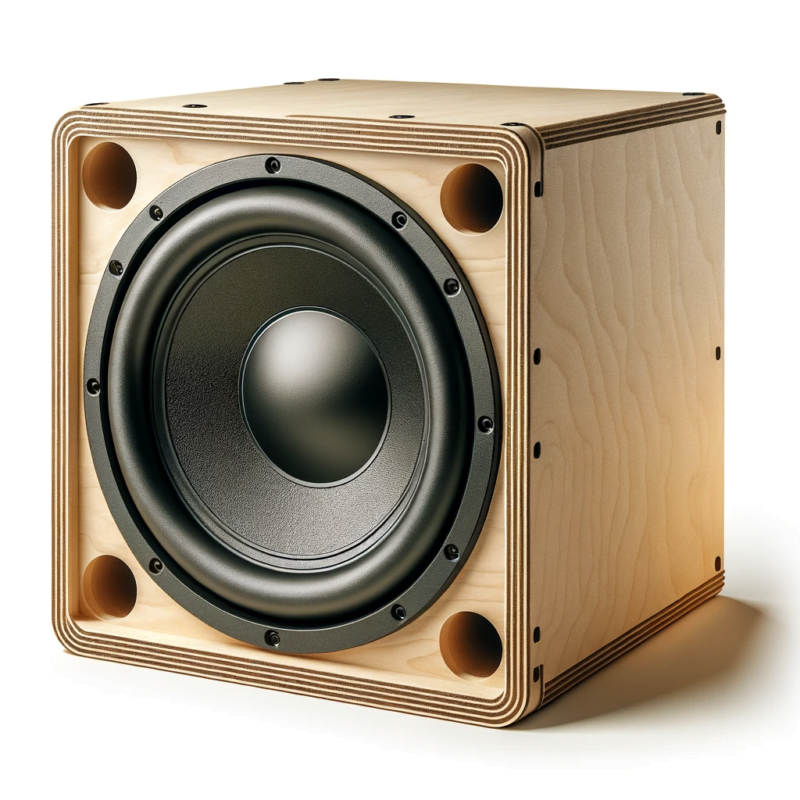Sealed Subwoofer Boxes: A Comprehensive Guide

Subwoofer boxes are an integral part of audio systems, significantly enhancing the bass response. These enclosures, available in various types, play a significant role in the sound quality of your audio experience. One such type of subwoofer box is the sealed subwoofer box, which offers unique proper characteristics and benefits. In this comprehensive guide, we will dive deep into sealed subwoofer boxes, understand their construction, design, and sound characteristics, and explore the benefits and drawbacks of using them. We will also compare sealed subwoofer boxes with other enclosures and provide tips on choosing the correct woofer box for your needs. So, let’s get started and learn everything you need to know about sealed subwoofer boxes!
What is a sealed subwoofer box, and how does it work?
A sealed subwoofer box is an enclosure that houses a subwoofer speaker. It is airtight, which allows the subwoofer to produce deep, accurate bass notes. The sealed box prevents air from escaping, causing the subwoofer to move more efficiently and produce a tighter, more controlled bass sound.
Understanding Subwoofer Boxes
subwoofer boxes, also known as speaker enclosures, are specially designed enclosures that house subwoofer drivers responsible for producing low frequencies or bass. These enclosures are available in different types, such as sealed enclosures, ported enclosures, bandpass enclosures, infinite baffle enclosures, and more. Each enclosure type offers other sound characteristics, allowing you to customize the bass response according to your preferences. In the context of understanding subwoofer boxes, it is essential to note the purpose of subwoofers.
A subsonic filter is a high pass filter for very low frequencies. Suppose the woofer is below the tuning frequency of the enclosure. In that case, there is no acoustic suspension for the woofer, which results in a lower performance similar to an infinite baffle. Essentially, this can damage the woofer’s suspension because of excessive cone travel (called “unloading”).
Importance of a Sealed Subwoofer Box (Sub Box) in Audio Quality
The subwoofer box plays a crucial role in the overall sound quality of audio systems, especially when it comes to bass reproduction. A well-designed subwoofer box ensures accurate bass response, good precision, and minimal sound distortions. It acts as a shock absorber, preventing damage to the subwoofer driver while providing optimal bass performance. In the case of sealed subwoofer enclosures, the accurate bass reproduction and sound quality make them a popular choice among audio enthusiasts.
Deep Dive into a Sealed Subwoofer Box
Delving deeper, we turn our attention to the intricate world of sealed subwoofer boxes, examining the nuances of their construction, the meticulous details of their design, and the unique sound characteristics they bring to the table. We will also explore the numerous advantages they offer, as well as address the potential drawbacks that come with their use.
In doing so, we aim to provide a comprehensive understanding of sealed subwoofer boxes, ensuring that you are well-equipped with the knowledge needed to make an informed decision when considering this particular type of audio equipment. Whether you’re an audiophile, a casual listener, or somewhere in between, understanding the ins and outs of sealed subwoofer boxes is crucial for optimizing your auditory experience.
Construction and Design of a Sealed Sub Box
Sealed subwoofer enclosures are typically constructed using durable Medium-Density Fiberboard (MDF) to ensure structural integrity and sound quality. The box volume, port length (if present), and driver displacement are essential factors in the design of dual-sealed subwoofer enclosures. Proper box dimensions, calculated based on the subwoofer specifications, ensure the best bass response and sound quality. It is crucial to seal the box correctly, avoiding any air leaks, as this can impact the performance of the dual subwoofer driver. The quality of the terminal cup, screw holes, and the use of silicone tape also contribute to the overall quality of the enclosure construction.
Sound Characteristics of a Sealed Woofer Box
Sealed subwoofer enclosures offer specific sound characteristics that make them stand out. These enclosures provide an accurate bass response, making them suitable for critical listening environments where sturdy precision is essential. The sealed design eliminates port noise, resulting in a cleaner reproduction of sound waves compared to ported enclosures. Sealed subwoofer boxes excel in reproducing kick drums, lower frequency instruments, and bass lines, providing a tight, controlled bass response. If you value accurate bass reproduction and sound quality, sealed subwoofer enclosures are an excellent choice.
Benefits of Using Sealed Subwoofer Boxes
Let’s delve into a thorough examination of the myriad advantages associated with the utilization of sealed subwoofer boxes. This feature has garnered immense popularity and widespread acclaim within the audiophile community. These meticulously crafted enclosures boast many benefits that significantly enhance the auditory experience, making them a preferred option for those passionate about sound quality.
From their compact and efficient design, which facilitates seamless integration into various settings, to the precision and clarity of the bass notes they produce, sealed subwoofer boxes are a testament to audio excellence. They offer a clean, tight bass response, making them the go-to choice for listeners who prioritize accuracy and detail in their sound reproduction. Furthermore, their simple yet effective construction reduces distortion and creates a more controlled sound environment, ensuring that every audio playback is delivered with the utmost fidelity. In delving deeper into the benefits of sealed subwoofer boxes, we uncover a world of auditory delight that has captivated the hearts and ears of audio enthusiasts around the globe.
Sound Precision and Quality
One of the significant advantages of sealed subwoofer enclosures is the sound precision they offer. The sealed design ensures accurate bass reproduction, capturing the details of low frequencies with precision. As the enclosure eliminates port noise, the bass response is clean and precise, enhancing the overall sound quality of the audio system. If you prefer accurate sound reproduction and sound quality, sealed subwoofer enclosures are the best bet for you.
Compact Size and Space Efficiency
Sealed subwoofer enclosures are known for their compact size, making them space-efficient for various installations. These enclosures require less space than ported enclosures, making them suitable for small vehicles or tight spaces. The small sealed subwoofer box can easily fit under seats, in the trunk, or in other limited areas without compromising sound quality.
The compact size of sealed subwoofer enclosures allows for flexible placement, maximizing the space in your vehicle or home theater setup while still delivering quality bass. When considering the system you can create, it is essential to consider the available room. If you drive a small hatchback and want to use your trunk for storage, you cannot expect to fit a powerful 15″ subwoofer inside, as it requires too much room.
Power Handling for a Small Sealed Subwoofer Box
While sealed subwoofer enclosures have lower power handling capabilities compared to ported enclosures, they are still suitable for low to medium-power amplifier setups. The sealed box design allows the subwoofer to handle power efficiently, preventing speaker damage and ensuring optimal performance. Proper power matching with the subwoofer driver is crucial to achieve the best sound quality and durability. Sealed subwoofer enclosures maximize power handling, delivering a controlled bass response that complements the audio experience.
Drawbacks of Using a Sealed Subwoofer Enclosure
While the myriad advantages of sealed subwoofer enclosures are widely celebrated, providing a plethora of reasons for their adoption in various audio setups, it is of paramount importance to adopt a balanced perspective and carefully weigh their potential drawbacks before making a final decision. These enclosures, despite their popularity and numerous positive attributes, come with certain limitations that could impact the overall user experience, depending on specific needs and preferences.
A sealed subwoofer box, known for its compact design and precise bass reproduction, might not be the perfect fit for every audio enthusiast or every type of audio application. It is crucial to delve into the nuances of their performance and understand where they might fall short, ensuring that your expectations align with the reality of what these enclosures can provide.
By taking a holistic view and considering the pros and cons, you equip yourself with the knowledge necessary to make an informed decision, ensuring that the audio equipment you choose aligns seamlessly with your desired auditory experience and setting. So, while the allure of sealed subwoofer enclosures is undeniable, a thoughtful examination of their potential downsides is an indispensable step in achieving audio perfection.
Need for Amplifier Power
To truly unleash the full potential of a sealed subwoofer box and ensure it operates at peak performance, it may necessitate the utilization of an amplifier with a higher power output when compared to its ported enclosure counterparts. This is a crucial aspect to consider in pursuing acoustic excellence, as the unique design of sealed enclosures inherently demands more power for effective functioning. The design of sealed subwoofer boxes is meticulously crafted to offer robust power handling capabilities, ensuring that they can stand up to the rigorous demands of intense audio playback.
However, this does not diminish the importance of carefully selecting a sealed subwoofer box that is well-suited to handle the elevated power output from your amplifier. Striking the right balance between the two is paramount, as it lays the foundation for achieving a sound output that is both powerful and pristine. Ensuring that your sealed subwoofer box can deliver those deep, sought-after low frequencies is an essential piece of the puzzle, and this becomes all the more critical when dealing with higher power outputs from your amplifier.
It’s not just about handling the power but transforming it into a bass response that is both responsive and resonant, encapsulating the listener in a rich, immersive auditory experience. In the quest for optimal sound quality and an unparalleled bass response, it’s vital to address and align these aspects of your audio setup. By doing so, you position yourself to experience the full breadth of what a sealed subwoofer box offers, ensuring that your investment in high-quality audio equipment translates into a listening experience that exceeds expectations and satisfies even the most discerning audiophiles.
So, when charting your course through the vast seas of audio equipment options, give due consideration to the power demands and capabilities of sealed subwoofer boxes and ensure that your choice is one that harmoniously aligns with the high-powered performance of your amplifier, guaranteeing a symphony of sound that is both exquisite and exhilarating.
Less Boom for Your Bass
While sealed subwoofer enclosures provide an accurate, controlled bass response, some audio enthusiasts may prefer a more boomy bass experience. Sealed enclosures focus on precise bass reproduction, reducing boomy bass and muddiness. This may not be ideal if you enjoy bass-heavy music genres, such as rap or electronic dance music, that emphasize the low-end frequencies. However, if you prioritize accurate bass response and sound quality, a sealed subwoofer enclosure, like a sealed sub, is the best choice for you. A sealed sub moderates the cone’s movement, resulting in a flat frequency response and tight, full bass that provides a level low-frequency foundation to your music.
Comparing Sealed Subwoofer Boxes
Now, let’s compare sealed subwoofer boxes with other types of enclosures, such as ported subwoofer boxes and bandpass subwoofer boxes, to understand the differences and advantages of sealed enclosures.
MDF Sealed vs. Ported Subwoofer Boxes
When comparing sealed subwoofer enclosures with ported enclosures, sealed enclosures offer a better low-frequency response. Sealed subwoofer enclosures, also known as vented enclosures, are known for accurate bass response, unlike ported enclosures, which can have a more boomy bass sound. The vented enclosure design provides tighter, more controlled bass, making them an excellent choice for accurate sound reproduction, especially in critical listening environments. Additionally, sealed subwoofer enclosures are space-efficient, making them suitable for small vehicles or tight spaces where ported enclosures may not fit.
Sealed Speaker Box vs. Bandpass Subwoofer Boxes
In comparing sealed subwoofer enclosures and bandpass enclosures, sealed enclosures excel in accurate bass response, unlike bandpass enclosures, which emphasize boomy bass. The sealed enclosure design of subwoofer boxes provides lower frequency response, ensuring precise bass reproduction without sacrificing sound quality. On the other hand, bandpass enclosures may deliver more low-end sound volume. Still, the bass quality may not be as accurate as a sealed speaker box, making sealed subwoofer enclosures the best choice for audio enthusiasts seeking exact sound quality.
How to Choose the Right Subwoofer Box for You?
Choosing the correct subwoofer box is crucial to achieve the sound quality you desire. Here are some tips to help you make the best decision:
Understanding Your Sound Preferences and Tuning Accordingly
Identify your sound preferences, whether you prefer accurate bass response, boomy bass, or balanced sound. Consider the frequency response you desire for your listening experience, and define the sound quality you are looking for when selecting the subwoofer box. Knowing your sound preferences will guide you toward the right enclosure type, including a sealed subwoofer box, to deliver the bass response and sound quality you desire.
Considering Your Vehicle Space
Measure the available space in your vehicle, home theater, or audio setup to ensure the subwoofer box fits without any space constraints. Consider the cubic feet of the subwoofer box that can be accommodated in your space without compromising sound quality or room aesthetics. Choose a subwoofer box size that fits the available space, allowing for proper installation, airflow, and speaker performance without taking up too much space. Take accurate measurements of the open space using a tape measure, ensuring the subwoofer box is compatible with your space. Explore this insightful topic further on our blog.
What Factors Influence the Performance of a Large Sealed Subwoofer Box?
A multitude of pivotal elements come into play when examining the performance capabilities of sealed subwoofer enclosures, all of which collaboratively work to guarantee the delivery of unparalleled sound quality and exceptional bass response. In this intricate exploration, we aim to shed light on these crucial factors, delving into how each one plays a vital role in shaping the auditory experience. Sealed subwoofer enclosures, renowned for their ability to provide crisp, clean bass, owe their performance to a complex interplay of design intricacies and material choices. The size of the enclosure, the quality of materials used, and the precision of construction all play indispensable roles in determining the final sound output.
The dimensions of the sealed enclosure are paramount, as they directly influence the air pressure inside the box, subsequently affecting the movement of the subwoofer cone and, ultimately, the sound quality. A well-calibrated balance between enclosure volume and subwoofer size results in an optimal bass response, showcasing the enclosure’s ability to handle lower frequencies quickly and precisely. Material selection is another critical factor, as the durability and rigidity of the enclosure materials ensure that unwanted resonances are minimized, preserving the purity of the bass notes. High-quality materials contribute to the enclosure’s ability to maintain its structural integrity, even under the pressure of intense bass notes, resulting in a more accurate and reliable performance.
The craftsmanship involved in constructing the sealed sub-enclosure cannot be overlooked. Precision engineering and meticulous assembly are essential in creating an airtight space, which is crucial for achieving the desired acoustic performance. Any gaps or weaknesses in the enclosure can lead to sound leakage, compromising the tightness of the bass and diminishing the overall sound quality. By considering these factors in detail, we uncover the intricate tapestry of elements that contribute to the superior performance of a sealed woofer box, highlighting their significance in achieving auditory excellence. This deep dive into the performance influencers of sealed subwoofer enclosures not only enriches our understanding but also accentuates their value in delivering a top-tier bass response and sound quality.
Conclusion
To summarize, sealed subwoofer boxes offer several advantages regarding sound precision, compact size, and power handling capabilities. They provide clean, tight bass that is well-suited for various music genres. However, it’s essential to consider the need for amplifier power and the potential for less booming bass compared to other subwoofer boxes. When choosing the correct subwoofer box for your needs, assess your sound preferences and the available space in your vehicle. Ultimately, the performance of sealed subwoofer boxes is influenced by factors such as the quality of the subwoofer itself, the enclosure design, and the placement within the vehicle. With careful consideration and proper installation, sealed subwoofer boxes can significantly enhance your audio experience.



